Despite water temps getting down to their average Winter lows of 15° the fishing quality is holding up very nicely.
Salmon have made their reliable appearance around the Heads but, as usual at this time of year, they are hard to catch. They will be at the Heads for a few months feeding on the small stuff and then will gradually move into the main Harbour over the following months with the bait. As the bait grows, the salmon will become easier to catch..
Trevally are in good numbers a little early this year and are at a good average size. They are spread throughout the lower Harbour with the main concentrations in North Harbour.
An unusual catch lately has been plagues of chinaman leatherjackets. We always get china jackets in the Harbour but usually in sizes so small they are not worth targeting but the latest run are up to 30cm and make great eating. They are in such plague proportions that we have even been getting them on trolled lures and if you are bait fishing for other species, they can become a nuisance.
Blackfish are our mainstay through the colder months and they haven’t let us down this season. They have been in good numbers around all the lower Harbour structure and are gobbling cabbage which is easily gathered of the ocean rocks. They bite best around the turn of the high while the water is moving but don’t be surprised if they go off the bite abruptly when the tide peaks. Don’t give up, though, because as soon as it starts running again they will come back on the bite.
We had an amazing session on jewfish and flatties up the Parramatta River while filming for our new DVD with local expert jewie Jim Siarakas. Despite the water being only 14° we had a plastics session that would rival any in Summer, landing 3 jewies and 17 flatties. The flatties were all about a kilo and the best jew was 9kg.
This got me to thinking about why plastics are such phenomenally successful lures. What is it about these lures that they have opened up whole new fisheries on traditionally ‘non-lure ‘ species like jew and bream and increased dramatically the success rate of traditional lure-takers like kings and flatties? It is quite possible now for a skilled SP user to do at least as well as someone using bait and this is something that has generally not been possible in the past.
Here are a few of my thoughts on the subject
The elimination of trebles on plastics is a major consideration because although most hard-bodied lures give their size specs to the length of the lure body, they do not including treble and bib length. There’s no problem with this from a sales point of view but from a fish’s point of view I have no doubt that they can see trebles and bibs and that they contribute to the overall size perception of the lure.
So while a hard bodied might be specified at 3cm, the actual size to the fish, when you add bib and trebles, is more like 5cm. Generally a 3cm SP is actually 3cm. You can cast a 3cm SP with lead head but, even if they existed, you could not cast a hardbody that measured an actual 3cm.
What about tiny metal slugs that actually measure 3cm? These have been around for years and while they certainly fit into the critical size bracket, their sink rate and snag-prone treble makes them unsuitable.
When it comes to fish like bream and whiting, lure size is critical.
This is just speculation on my part and is almost impossible to prove (as with the colour debate) but I believe that the ‘quietness’ of soft lures is a major player on some species.
This theory is based on throwing lures at kings and other pelagic for at least 150 days a year for the last 15 years (approximately 9000 kings) so it does carry some credibility. Someone is sure to remind me of a time when they caught a king on a rattler but in my experience you will get kings on a SP-to-minnow ratio of about 50:1.
Similarly, you will pick up a bream using a 10cm lure but when you know that you will get 10 times more bream on a 3cm lure, the choice becomes pretty clear.
There are always exceptions to every rule in fishing and someone will contradict your theory with a story about a freak capture but my advice is that if you want consistent results, then stick with the averages.
Freshwater and estuary species are probably exempt from this theory as they feed on a whole host of critters, some of which are noisy like crabs, bass, yabbies and terrestrial critters like cicadas and beetles.
Fish like kings and other pelagics whose diet is primarily soft-bodied baitfish and squid are not used to hearing their prey click, rattle and hum. SPs in general, but particularly stickbaits, are silent through the water.
A hard lure doesn’t have to have added rattles to become highly audible underwater. Rings and trebles make more than enough racket to shy off a noise-sensitive fish. Of course SPs aren’t the only silent lures available. Fixed-hook jobs like the old Smiths jigs, flies and feathers all carry the same silent attributes and, surprise, surprise, they are also top king producers.
It’s been touted for years that the soft-bodied feel to plastics is a major attribute in relation to fish biting down and holding on longer, giving the angler more time to react. This is all very true but I think that there more to it than just this critical point of impact.
SPs are the closest lure we have to the feel and consistency of most fishes’ natural prey. So it would probably be fair to assume that when a SP bounces off a snag or hits the bottom it will have a similar sound/feel to real prey.
Furthermore, the ‘vibes’ put off by the undulations of a plastic moving through the water will be closer to that of a natural baitfish.
The depth capabilities of plastics are another advantage. Metal slices can be worked deep but their sink rate and clunky vibe make them unattractive.
Plastics can be used to keep contact with the bottom all the way back to the boat or shore. What I’m talking about here is bouncing the bottom, not just staying close, and there seems to be a huge difference.
Hitting the bottom and then taking off again seems to trigger an aggressive strike response. Maybe it’s the puff of mud as the lure takes off or maybe it’s just a natural wounded-baitfish characteristic, who knows, but this is the first time in fishing history where we have bounced the bottom properly in water as deep as 12m.
With the exception of the very rare suspending bait (neutral buoyant minnow), a conventional minnow crankbait will rise to the surface if you stop cranking. This, by default, takes it out of the strike zone and creates an unnatural presentation.
If you stop cranking a metal lure it falls rapidly to the bottom and, once again, is not conducive to a natural presentation.
Plastics have the advantage that you can add or subtract weight so that they do anything in between sinking fast or floating but, most importantly, they can be weighted for neutral buoyancy. In an uncomplicated but not entirely technically correct definition, this means that they can be suspended in mid-water. This is very good and natural and is exactly what the swim bladder of most fish is designed to do.
You can see the advantage of being able to imitate this. A wounded baitfish does not rapidly sink to the bottom or float to the surface when it stops swimming; it suspends.
The extra benefit of this natural presentation is our ability to hold the lure in the strike zone. A well-weighted plastic can be allowed to sink to the required depth (even though this may take some patience) and then be worked as slowly as you want without rising or sinking out of the strike zone.
A sharp flick will educed an erratic dart from the lure but then you can do nothing for 10 seconds and be sure that the lure is still in the zone.
Plastics, with their porous skin, optional ‘pockets’ and manufacturers’ ability to ‘cook’ additives into the mix, lend themselves very well to scenting. The new Storms have a hole down through the middle so that you can soak a piece of cotton wool in scent and jam it in to create a trail that will sustain for many hours. If you doubt that plastics are porous, try leaving one in water for a few days.
Scent is an obvious advantage but the challenge in the future will be to determine at which point a lure becomes a bait. I’m surprised that this hasn’t already become more of an issue on the tournament circuit.
Take, for example, a Berkley Gulp. I know for sure that fish will eat these even if they are tossed out on a hook and left to sit on the bottom without any retrieve at all. Is it a lure or a bait?
This issue will be further exacerbated by the manufacturer’s claim that they are biodegradable. This may not seem a big deal to the average fisho but when you consider the five-figure prizemoney now creeping into tournaments, you can see why this will have to be defined shortly. Maybe the definition could include a clause as to whether a fish could derive sustenance from the product because, after all, anything else is a deception as per the definition of a ‘lure’.
A single hook point is easier to set than two points of a treble and a wide-gape hook gets a better bite than a small one. The hook size of a soft plastic is always bigger than an equivalent-sized treble hook. This means that they are easier to set and that they will hold better, equating to fewer missed strikes and pulled hooks.
An upward-riding hook, as those found on most sinking SPs, will snag up less on the fall into timber snags and on the bottom. With well-designed bottom-bouncing plastics, the upward-riding hook offers better exposure when a fish picks up a lure off the bottom.
Whether it’s a naturally buoyant stickbait sinking horizontally or a grub or paddletail fluttering with water pressure on the way down, most plastics are ‘working’ before you ever turn the reel handle.
This can often compensate for bad retrieve techniques, meaning that, short of just leaving your lure sitting on the bottom, you are in with a chance no matter how bad your retrieve technique.
It also means that you have to be ready to feel hits on the fall. The soft feel gives you more time to strike and this all adds up to being a good lure for first-time chuckers. Having said that, there is no doubt that a refined technique turns these lures from good lures to phenomenal fish-catchers.
So here we have a lure suited to beginners and pros alike.
The massive options of combinations found with plastics means that we have a lure type suitable for everything from bass to billfish. We have the option of working everything from surface popping to the deepest fishable depths.
Take, for example, the traditional 4” grub tail. You could put it on a heavy lead head and fish the depths of an estuary for flatties or jew. The same tail could be pinned on a slow-fall head and used to fish a midwater snag for Murray cod or yellas. You could then put it on an unweighted worm hook and fish surface-smashing Summer bass.
Big stickbaits have been used to take billfish; tiny grub tails work on bream and whiting; lightly weighted grub tails catch berley-trail snapper and uncooperative ‘match the hatch’ salmon devour tiny stickbaits.
There’s no other lure type than can match the versatility of plastics.
Reads: 1379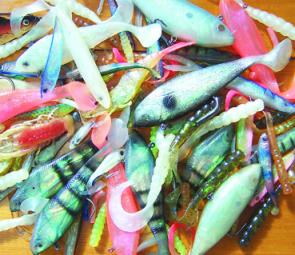
Soft plastics come in all shapes, sizes and rigging patterns – and they’re all versatile fish-catchers.
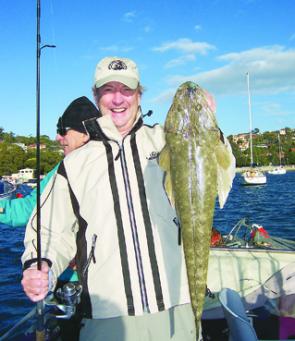
Flathead are everyone’s soft plastic targets and it doesn’t matter how deep the fish are, an appropriately weighted plastic will get to them.
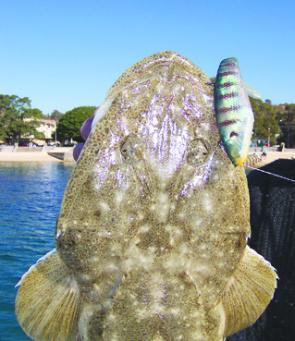
Pre-rigged plastics, especially shad patterns, are now widely available and take a lot of rigging and weighting decisions out of the equation.

Bream respond strongly to downsized plastics, especially those weighted to give natural action.
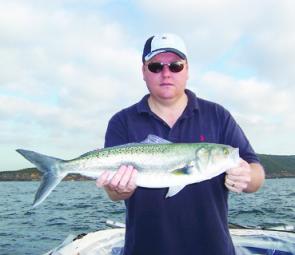
Salmon chasing tiny baitfish are more likely to attack a small plastic that ‘matches the hatch’.
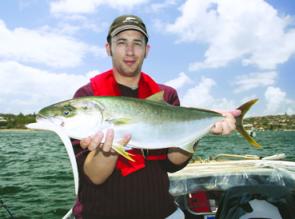
Kingfish can be notoriously wary and fussy but when an unweighted soft stickbait hits the water, the silent, soft flutter can be too much to resist.




